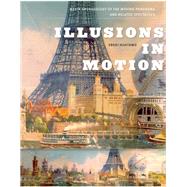Illusions in Motion Media Archaeology of the Moving Panorama and Related Spectacles
, by Huhtamo, Erkki- ISBN: 9780262018517 | 0262018519
- Cover: Hardcover
- Copyright: 2/22/2013
Beginning in the late eighteenth century, huge circular panoramas presented theiraudiences with resplendent representations that ranged from historic battles to exotic locations.Such panoramas were immersive but static. There were other panoramas that moved--hundreds, andprobably thousands of them. Their history has been largely forgotten. In Illusions inMotion, Erkki Huhtamo excavates this neglected early manifestation of media culture in themaking. The moving panorama was a long painting that unscrolled behind a "window" by meansof a mechanical cranking system, accompanied by a lecture, music, and sometimes sound and lighteffects. Showmen exhibited such panoramas in venues that ranged from opera houses to church halls,creating a market for mediated realities in both city and country. In the firsthistory of this phenomenon, Huhtamo analyzes the moving panorama in all its complexity,investigating its relationship to other media and its role in the culture of its time. In histelling, the panorama becomes a window for observing media in operation. Huhtamo explores suchtopics as cultural forms that anticipated the moving panorama; theatrical panoramas; the diorama;the "panoramania" of the 1850s and the career of Albert Smith, the most successful showman of thatera; competition with magic lantern shows; the final flowering of the panorama in the latenineteenth century; and the panorama's afterlife as a topos, traced through its evocation inliterature, journalism, science, philosophy, and propaganda.






